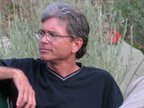When I stepped out of the Powell Street BART station in the early evening this past Saturday, I was greeted by a panhandler asking me for a dollar. There were at least two dozen people standing at the crosswalk on Market, but he singled me out. I've grown accustomed to this--for some reason, the street people see me as an easy mark. I've been in groups, both large and small, many times in many cities, and I'm invariably approached while the others are ignored. I don't usually give in, and didn't this time, but on occasion, if the fellow is funny or creative in his asking, I will hand over some coins. My dad had a soft spot for the underclass, and often chatted them up, and his recognition of their humanity was one of his best qualities. On the other side of Hallidie Plaza, I turned west on Eddy Street and reveled in the fresh ocean breeze that whipped my face and jacket. It had been hot and stuffy in the transbay tube and underground stations. I was mere steps from two fellows being cuffed by four of San Francisco's finest. They looked like high school kids. I suspect they were nicking the tourists, whose free-flowing dollars the City by the Bay lives on. The next block was Mason, and I turned left again after crossing, and noticed that my destination was on the other side. As I went back down toward the corner at Turk to cross, a terrifyingly skinny and hard-bitten women hit me up like we were old friends, happy to see me and ready for a good time. I suppose, in my neat jeans, brown walkers, dress shirt, and tweed sport coat, I looked like a real rube, and she saw opportunity knocking. My refusal was curt, and she chided me for my lack of good humor, but turned away and continued on with her ancient profession. Finally, I found my spot on the east side of the street, right at the foot of Mason. It was six o'clock, and they were just opening the doors of the
50 Mason Social House. I was the first person at the bar so I picked out the best seat and ordered a
Trumer Pils and waited for the show to begin.
The event was a book release and signing party. The star was local author and minor celebrity
Will Viharo, whose
Love Stories Are Too Violent For Me was just re-issued by
Gutter Books. He was joined by Philadelphia-based author
T. Fox Dunham, whose debut novel
The Street Martyr was also hot off
Gutter's presses. Entertainment was provided by San Francisco's own
Aqua Velvets, surf band extraordinaire. Apparently Mr. Viharo wrote much of
Love Stories with the band in the background, and they get a mention in the book as well. I got the chance to talk to guitarist and songwriter Miles Corbin and his musical partner and the band's bassist Michael Linder, telling them how much I loved their music, particularly the 1997 album
Guitar Noir. Both were gracious and friendly. I bought two CDs from Miles and Michael gave me one of his own, a collection of bands he produces. If the
Tenderloin was the perfect neighborhood for a noir fiction event, the Velvets were the perfect soundtrack.
Things got underway about seven.
Matthew Louis, head honcho at
Gutter Books, arrived and I helped him set up the table. I met both authors and two other crime writers (and
Gutter editors)
Joe Clifford and
Tom Pitts. Everyone was in a jolly mood and the party went swimmingly. I'd met Matt Louis once before, only because he's from Medford, Oregon (an hour north of here), and I worked with him briefly a few years back because he published two stories of mine in his pulp 'zine
Out of the Gutter. Those remain my only published pieces. I hope to rectify that in the near future. Matt is slight of build and his boyish good looks belie his incipient middle age, but the man's sinews are pure tungsten steel. He built his small press, independent publishing venture with sweat, determination, and a single-minded focus to do things his way. He has an eye for talent and a real ear for the kind of fiction he wants to produce. Take a look at Mr. Dunham's blog and
his description of Matt's editorial intensity. In a world where the big publishing houses are increasingly swallowing each other up, and the same authors are endlessly hyped
ad nauseum, readers like me are starved for new voices. The small presses are like microbreweries--most have no chance to compete with the majors. But some, through hard work and a devotion to quality and uniqueness, survive, and even thrive. I think, and I hope, that
Gutter Books is one of the latter.
After the readings, book signings, and musical interludes, the party ended. I was fortunate to spend some time with Fox Dunham, who is a fascinating man. Originally from Scotland, he trained in the ancient bardic traditions with his grandfather, learning not only Scots Gaelic, but about the
awen, the source of poetic inspiration. A cancer survivor and denizen of the mean streets, Fox has a palpable empathy for the dispossessed and disenfranchised. His reading from
The Street Martyr had the crowd mesmerized. He inscribed my copy of his book "Speak for those with their mouths torn out." What a powerful sentiment!
Later, around ten o'clock, a small group went up the street a half block for a couple more pints. I was able to visit longer with Matt and his lovely and charming bride, and schmooze with the featured authors and the rest of the
Gutter crowd, most of whom had brought their significant others. Alas, my darling stayed home this weekend, and I had to be on my own, but I had a grand and inspiring adventure nonetheless. I discovered that writers, editors, and publishers are real people, and that noir-types are regular Joes (and Janes). I had to dash off a little after 11:30 and catch the midnight train back across the Bay. My head didn't hit the pillow (I stayed at my Mom's in Benicia) until after one a.m. I was tired on the long, hot drive home on Sunday, but surprisingly fulfilled. Even the Giants getting swept at home by the Cubs could not dampen my mood. I plan to retire from my current profession--public high school teacher--in June of 2014, and pursue writing full-time. Whether it brings me success or not, I've come to realize, is not as important as the chance to discover things about myself. And if it brings me into more contact with the kinds of folks I spent Saturday night with, so much the better. Next up:
NoirCon 2014 in Philadelphia!








